Henderson's brittlebush
(Petrophytum hendersonii)

Description
Petrophytum hendersonii, commonly known as Henderson's rock spirea or Henderson's brittlebush, is a species of flowering plant in the Rosaceae family. It is native to the western United States, specifically the Great Basin region of Nevada, Utah, Idaho, and Wyoming, as well as parts of California, Oregon, and Washington. This species is known for its striking white to pinkish-white flowers that bloom in the late spring and summer months. Description Petrophytum hendersonii is a small, low-growing shrub that typically reaches a height of 20-50 cm (8-20 in) and a width of 30-60 cm (12-24 in). It has woody stems that are covered in small, gray-green leaves that are divided into three leaflets. The leaves are typically 1-2 cm (0.4-0.8 in) long and 0.5-1 cm (0.2-0.4 in) wide. The flowers of Petrophytum hendersonii are borne in clusters at the ends of the stems. They are small, measuring only 3-4 mm (0.1-0.2 in) in diameter, but are arranged in large, showy inflorescences. The flowers are white to pinkish-white in color, with five petals that are deeply lobed and arranged in a star-like shape. Distribution and Habitat Petrophytum hendersonii is found in a variety of habitats, including rocky slopes, cliffs, and canyons. It is typically found at elevations between 1,200 and 3,000 meters (4,000-10,000 ft) above sea level. This species is adapted to arid conditions and is often found in areas with low rainfall and high temperatures. Petrophytum hendersonii is found in several different regions in the western United States. Its range includes parts of Nevada, Utah, Idaho, and Wyoming, as well as parts of California, Oregon, and Washington. Cultivation Petrophytum hendersonii is a popular ornamental plant in rock gardens and other xeric landscapes. It is a hardy plant that is relatively easy to grow and requires little maintenance once established. This species prefers well-drained soils and full sun to partial shade. It is tolerant of drought and heat and is an excellent choice for gardens in hot, arid climates. It is also deer-resistant, making it a good choice for areas with high deer populations. Propagation of Petrophytum hendersonii can be achieved through seeds or cuttings. Seeds should be sown in the fall, while cuttings can be taken in the spring or early summer. Uses Petrophytum hendersonii has traditionally been used by Native American tribes for medicinal purposes. The plant was used to treat a variety of ailments, including colds, coughs, and sore throats. In addition to its medicinal uses, Petrophytum hendersonii has been used by Native Americans for basketry and other crafts. The plant's woody stems are flexible and strong, making them ideal for weaving. Conservation Status Petrophytum hendersonii is considered a species of least concern by the International Union for Conservation of Nature (IUCN). However, like many species in the Great Basin region, it is threatened by habitat loss and fragmentation caused by development and other human activities. In addition, climate change and increased fire frequency may also pose a threat to this species in the future. Efforts are underway to conserve Petrophytum hendersonii and other rare and endangered species in the Great Basin region through habitat restoration, invasive species management, and other conservation measures.
Taxonomic tree:







